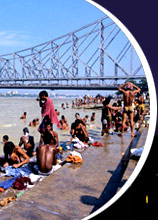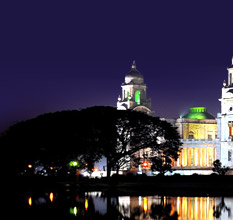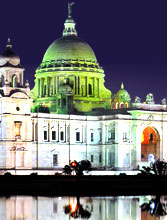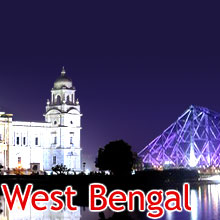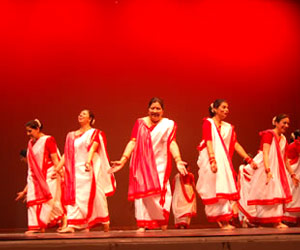 The culture of West Bengal is considered to be one of the richest cultures in India. Apart from boasting of its immense contribution in reformation movements, the state also takes the credit for being the pioneer of cosmopolitan culture in the country. Over the years, the culture of West Bengal has emerged as the perfect blend of modernity and traditions. The sanctity of Hooghly, the beauty of Eastern Himalayas, the diversity of Sunderbans and the freshness of the Tea Gardens, all blend together to constitute what we call the unique culture of West Bengal. Bengali culture also has its root in Bengali music, Bengali cinema and Bengali literature. The delicious Bengali cuisine also forms an important constituent of the state's cultural heritage.
The culture of West Bengal is considered to be one of the richest cultures in India. Apart from boasting of its immense contribution in reformation movements, the state also takes the credit for being the pioneer of cosmopolitan culture in the country. Over the years, the culture of West Bengal has emerged as the perfect blend of modernity and traditions. The sanctity of Hooghly, the beauty of Eastern Himalayas, the diversity of Sunderbans and the freshness of the Tea Gardens, all blend together to constitute what we call the unique culture of West Bengal. Bengali culture also has its root in Bengali music, Bengali cinema and Bengali literature. The delicious Bengali cuisine also forms an important constituent of the state's cultural heritage.Culture Of West Bengal
History of West Bengal
The present culture of Bengal has its roots in the history of the state. In the past, Bengal kept shuffling between the hands of various rulers, making it exposed to different cultures. Mauryans, Guptas and Palas were succeeded by Sena Dynasty, who lost Bengal to Qutb-Din-Ibaq, the Sultan of Delhi. After the death of Aurangzeb, Bengal became independent, with Muslim governors running the administration. The Battle of Plassey, in 1757, saw Siraj-ud-daul, the last independent ruler of Bengal, being defeated by the British. In 1947, with the independence of India, Bengal was divided into East and West Bengal, with the former being given to Pakistan and the latter being made a part of India.
Bengali People
There is a popular saying 'What Bengal thinks today, Rest of the India will think tomorrow'. This tells what a rich genetic inheritance the people of Bengal have. Bengal has been home to great social reformers like Raja Ram Mohan Roy and Vidyasagar. The great saint Ram Krishna Param Hans and Nobel Laureate Rabindra Nath Tagore also had their roots in Bengal's soil. Today, Bengalis reflect a mixture of traditional values and modern traditions. They have deep affinity toward art, craft and music and mainly believe in socialism.
Religions in West Bengal
People belonging to almost all the religions practiced in India can be seen in West Bengal. However, Hindu and Muslim domination still prevails. The minority communities in the state include Christians, Buddhists, Sikhs and Jains. Fairs and festivals form an important part of all the religions of Bengal. It is said that in Bengal, there is a festival for every season, every region and every occasion. Apart from the grand festivals, like Durga Pooja, Diwali and Id, small sects organize fairs at various dargahs and mandirs in West Bengal.
Bengali Theatre
The theatre in Bengal dates back to 18th century. Reflecting the rich art and cultural lineage of the state, it gained prominence during the freedom struggle of India, when it was used as a tool of expression. Apart from the religion folk dramas prevalent in many parts of Bengal, Bengali plays with nationwide popularity are also churned out on a regular basis. Girishchandra Ghosh, Rabi Roy, Sisir Bhaduri, Badal Sircar, Shobha Sen and Soumitra Chatterjee are some of the prominent names in Bengali theatre.
Bengali Cinema
The tryst of Bengal with cinema began in 1890s, when the first "bioscopes" became popular in Kolkata theaters. By 1900, the first production company in Bengal was set up, by Hiralal Sen, named the Royal Bioscope Company. The first Bengali movie, Billwamangal, was released on 8th November 1919, only six years after the first full-length Indian feature film, Raja Harish Chandra. In contemporary phase, the immense contribution of great Bengali director Satyajit Ray can not be ignored. Other prominent film makers in the Bengali film industry are Bimal Roy, Ritwik Ghatak, Rituparno Ghosh and Aparna Sen.
Bengali Literature
Bengali literature is regarded as one of the richest in the world. Michael Madhusudan Dutt, Bankim Chandra Chattopadhyay, Dinabandhu Mitra, Raja Ram Mohan Roy, Kazi Nazrul Islam, Rabindra Nath Tagore, Sharat Chandra and Ishwar Chandra Bandyopadhyaya are some of the classic names in Bengali literature. The first evidence of Bengali literature is formed by a collection of 8th-12th century CE Buddhist mystic poems from Eastern India, named Charyapada or Charyageeti. The first Bengali novel was Alaler Ghorer Dulal. Bengali literature includes a variety of classic prose, poetries and fiction and non-fiction drama.
Tribes in West Bengal
A discussion on the culture of West Bengal is incomplete without the mention of its tribal population. There is a variety of tribes found in almost all the nooks and corers of the state, which add a beautiful flavor to its culture. About 38 in number, the tribes comprise nearly 2% of the entire population of West Bengal.
Bengali Music
Bangla Music forms an important part of Bengali cultural heritage. In fact, the music of West Bengal compliments and adorns its culture. There is a lot of variety within Bengali music, from Bangla classic to Banga folk and even rock. Apart from the vocal and instrumental classic, Majlishi classic (with thumri and toppa) form an important part of Bengali Music. Then, there is the Rabindra Sangeet, Ganasangeet, Jeeban mukhi gaan and Bengali film song.
Bengali Cuisine
Bengali people are considered to be great foodies and the appreciators of good taste. The staple Bengali food comprises of rice and fish. Fish recipes also form a part of every festive celebration in Bengal. Salmon, Hilsa, Bhekti, Magur, Carp, Rui and Prawns are some common verities of fish cooked in the state. The typical Bengali food has a distinct kind of taste, due to the use of mustard oil and panch-foran (mix of five special types of species). The perfect blend of sweet and spicy flavors in dishes is considered the forte of Bengali cuisine.

